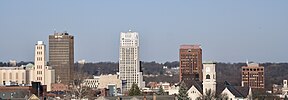
Back Akron AN آكرون Arabic آكرون ARZ Akron (Ohio) AST اکران، اوهایو AZB Акран (Агая) Byelorussian Акрън Bulgarian Akron (Ohio) Breton Akron (Ohio) Catalan Акрон (Огайо) CE
Akron | |
|---|---|
| Etymology: from Ancient Greek ἄκρον (ákron) 'summit, high point' | |
| Nicknames: Rubber City, City of Invention, Rubber Capital of the World (historical) | |
 Interactive map of Akron | |
| Coordinates: 41°04′50″N 81°31′20″W / 41.08056°N 81.52222°W | |
| Country | United States |
| State | Ohio |
| County | Summit |
| Founded | 1825 |
| Incorporated | 1836 (village) |
| Incorporated | 1865 (city) |
| Founded by |
|
| Government | |
| • Type | Mayor–council |
| • Mayor | Shammas Malik (D) |
| Area | |
| • City | 62.27 sq mi (161.29 km2) |
| • Land | 61.93 sq mi (160.41 km2) |
| • Water | 0.34 sq mi (0.88 km2) 0.55% |
| Elevation | 945 ft (288 m) |
| Population (2020) | |
| • City | 190,469 |
| • Estimate (2023)[3] | 188,701 |
| • Rank | US: 136th |
| • Density | 3,075.40/sq mi (1,187.42/km2) |
| • Urban | 541,879 (US: 79th) |
| • Urban density | 1,802.4/sq mi (695.9/km2) |
| • Metro | 702,219 (US: 83rd) |
| Demonym | Akronite |
| Time zone | UTC−5 (Eastern (EST)) |
| • Summer (DST) | UTC−4 (EDT) |
| ZIP code | 44301-44321, 44325-44326, 44328, 44333-44334, 44372, 44396, 44398 |
| Area codes | 234, 330 |
| FIPS code | 39-01000 |
| GNIS feature ID | 1086993[2] |
| Website | www |
Akron (/ˈækrən/) is a city in and the county seat of Summit County, Ohio, United States. At the 2020 census, the city proper had a total population of 190,469, making it the fifth-most populous city in Ohio and 136th-most populous city in the U.S. The Akron metropolitan area, covering Summit and Portage counties, had a population of 702,219.[4] It is located on the western edge of the Glaciated Allegheny Plateau in Northeast Ohio about 40 miles (64 km) south of downtown Cleveland.
After being first settled by Miner Spicer in 1810,[5] the city was founded by Simon Perkins and Paul Williams in 1825 along the Little Cuyahoga River at the summit of the developing Ohio and Erie Canal. The name is derived from the Greek word ἄκρον (ákron), signifying a summit or high point. It was briefly renamed South Akron after Eliakim Crosby founded nearby North Akron in 1833, until both merged into an incorporated village in 1836. In the 1910s, Akron doubled in population, making it the nation's fastest-growing city.
A long history of rubber and tire manufacturing, carried on today by the Goodyear Tire and Rubber Company, gave Akron the nickname "Rubber Capital of the World". It was once known as a center of airship development.[6][7] Today, its economy includes manufacturing, education, healthcare, and biomedical research; leading corporations include Gojo Industries, FirstEnergy, Huntington Bank, and Charter Spectrum.
Notable historic events in Akron include the passage of the Akron School Law of 1847, which created the K–12 system; the popularization of the church architectural Akron Plan, the foundation of Alcoholics Anonymous, the Akron Experiment into preventing goiters with iodized salt, the 1983 Supreme Court case City of Akron v. Akron Center for Reproductive Health; and portions of the 2014 Gay Games. A racially diverse city, it has seen noted racial relations speeches by Sojourner Truth in 1851 (the Ain't I A Woman? speech), W. E. B. Du Bois in 1920,[8] and President Bill Clinton in 1997.[9] In 1914, Marcus Garvey founded the Universal Negro Improvement Association in Kingston, Jamaica; its Akron branch opened in 1921.[8][10] Episodes of major civil unrest in Akron have included the riot of 1900, rubber strike of 1936, the Wooster Avenue riots of 1968, and the 2022 protests surrounding the killing of Jayland Walker.
- ^ "ArcGIS REST Services Directory". United States Census Bureau. Retrieved September 20, 2022.
- ^ a b U.S. Geological Survey Geographic Names Information System: Akron, Ohio
- ^ "Annual Estimates of the Resident Population for Incorporated Places in Ohio: April 1, 2020 to July 1, 2023". United States Census Bureau. Retrieved May 17, 2024.
- ^ "American FactFinder". United States Census Bureau. Archived from the original on February 12, 2020. Retrieved January 6, 2013.
- ^ Cite error: The named reference
:0was invoked but never defined (see the help page). - ^ "Butler: Clay Products". Akronhistory.org. Archived from the original on June 23, 2012. Retrieved September 9, 2012.
- ^ Howe, Henry (1896). "Historical collections of Ohio: An encyclopedia of the state: History both general and local, geography with descriptions of its counties, cities and villages, its agricultural, manufacturing, mining and business development, sketches of eminent and interesting characters, etc., with notes of a tour over it in 1886". state of Ohio, Laning printing Company. p. 631.
Paul Williams founder akron ohio.
- ^ a b Cite error: The named reference
Akron: Akron's Black History Timeline: 1900-1919: The New Centurywas invoked but never defined (see the help page). - ^ Cite error: The named reference
Akron Ohio Historical Timeline 1950 - 1999was invoked but never defined (see the help page). - ^ Giffin, William (2005). African Americans and the Color Line in Ohio, 1915–1930. Thompson Shore, Inc. p. 210. ISBN 9780814210031 – via Google Books.









